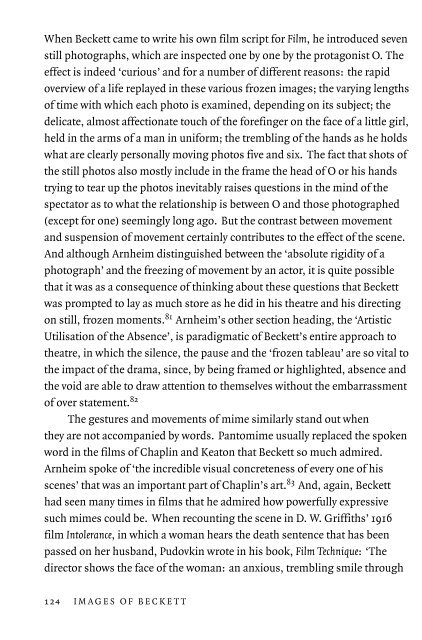Create successful ePaper yourself
Turn your PDF publications into a flip-book with our unique Google optimized e-Paper software.
When <strong>Beckett</strong> came to write his own film script for Film, he introduced seven<br />
still photographs, which are inspected one by one by the protagonist O. The<br />
effect is indeed ‘curious’ and for a number <strong>of</strong> different reasons: the rapid<br />
overview <strong>of</strong> a life replayed in these various frozen images; the varying lengths<br />
<strong>of</strong> time with which each photo is examined, depending on its subject; the<br />
delicate, almost affectionate touch <strong>of</strong> the forefinger on the face <strong>of</strong> a little girl,<br />
held in the arms <strong>of</strong> a man in uniform; the trembling <strong>of</strong> the hands as he holds<br />
what are clearly personally moving photos five and six. The fact that shots <strong>of</strong><br />
the still photos also mostly include in the frame the head <strong>of</strong> O or his hands<br />
trying to tear up the photos inevitably raises questions in the mind <strong>of</strong> the<br />
spectator as to what the relationship is between O and those photographed<br />
(except for one) seemingly long ago. But the contrast between movement<br />
and suspension <strong>of</strong> movement certainly contributes to the effect <strong>of</strong> the scene.<br />
And although Arnheim distinguished between the ‘absolute rigidity <strong>of</strong> a<br />
photograph’ and the freezing <strong>of</strong> movement by an actor, it is quite possible<br />
that it was as a consequence <strong>of</strong> thinking about these questions that <strong>Beckett</strong><br />
was prompted to lay as much store as he did in his theatre and his directing<br />
on still, frozen moments. 81 Arnheim’s other section heading, the ‘Artistic<br />
Utilisation <strong>of</strong> the Absence’, is paradigmatic <strong>of</strong> <strong>Beckett</strong>’s entire approach to<br />
theatre, in which the silence, the pause and the ‘frozen tableau’ are so vital to<br />
the impact <strong>of</strong> the drama, since, by being framed or highlighted, absence and<br />
the void are able to draw attention to themselves without the embarrassment<br />
<strong>of</strong> over statement. 82<br />
The gestures and movements <strong>of</strong> mime similarly stand out when<br />
they are not accompanied by words. Pantomime usually replaced the spoken<br />
word in the films <strong>of</strong> Chaplin and Keaton that <strong>Beckett</strong> so much admired.<br />
Arnheim spoke <strong>of</strong> ‘the incredible visual concreteness <strong>of</strong> every one <strong>of</strong> his<br />
scenes’ that was an important part <strong>of</strong> Chaplin’s art. 83 And, again, <strong>Beckett</strong><br />
had seen many times in films that he admired how powerfully expressive<br />
such mimes could be. When recounting the scene in D. W. Griffiths’ 1916<br />
film Intolerance, in which a woman hears the death sentence that has been<br />
passed on her husband, Pudovkin wrote in his book, Film Technique: ‘The<br />
director shows the face <strong>of</strong> the woman: an anxious, trembling smile through<br />
124 IMAGES OF BECKETT


